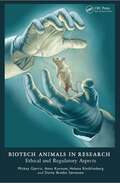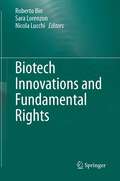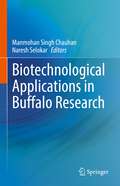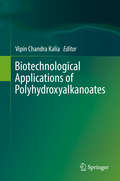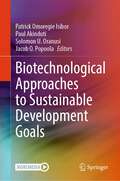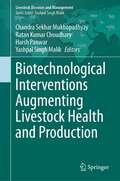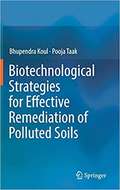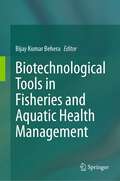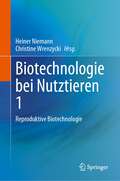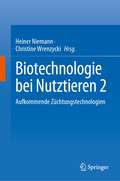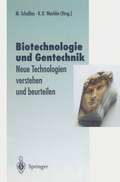- Table View
- List View
Biotech Animals in Research: Ethical and Regulatory Aspects
by Mickey GjerrisThis book explores central aspects of genetic modification of animals for scientific purposes in the context technological possibilities, regulatory issues in different regions, animal welfare implications and wider ethical issues exemplified through current theories and frameworks. This discussion of lab animals produced through modern biotechnologies becomes increasingly pressing as CRISPR-Cas9 technology advances rapidly, challenging legal and ethical frameworks all over the world. Such animals are now affordable and readily available to almost every branch of scientific research. This not only raises enormous potential for creating ‘tailored’ models for human diseases but also rubs up against the traditional guiding principles (the 3Rs) for the humane use of animals for scientific experiments and raises wider ethical issues around death, integrity and naturalness. In this book, expert authors from diverse backgrounds in laboratory animal care, animal research, technology and animal rights explore a range of topics, from the science behind biotech research animals and the regulation of their use, to utilitarian, animal rights, virtue ethics and ethics of care, and critical animal studiers' perspectives on the use of these technologies. Whatever your background or role in animal research, this book will challenge and stimulate deeper consideration of the benefits, disadvantages and ethical consequences of the use of biotechnology in the animal laboratory.
Biotech Animals in Research: Ethical and Regulatory Aspects
This book explores central aspects of genetic modification of animals for scientific purposes in the context technological possibilities, regulatory issues in different regions, animal welfare implications and wider ethical issues exemplified through current theories and frameworks. This discussion of lab animals produced through modern biotechnologies becomes increasingly pressing as CRISPR-Cas9 technology advances rapidly, challenging legal and ethical frameworks all over the world. Such animals are now affordable and readily available to almost every branch of scientific research. This not only raises enormous potential for creating ‘tailored’ models for human diseases but also rubs up against the traditional guiding principles (the 3Rs) for the humane use of animals for scientific experiments and raises wider ethical issues around death, integrity and naturalness. In this book, expert authors from diverse backgrounds in laboratory animal care, animal research, technology and animal rights explore a range of topics, from the science behind biotech research animals and the regulation of their use, to utilitarian, animal rights, virtue ethics and ethics of care, and critical animal studiers' perspectives on the use of these technologies. Whatever your background or role in animal research, this book will challenge and stimulate deeper consideration of the benefits, disadvantages and ethical consequences of the use of biotechnology in the animal laboratory.
Biotech in China: Innovation, Politics, and Economics
by Rolf Schmid Xin XiongIn her quest for global leadership in science and technology, the People’s Republic of China has attained top ranks in the number of scientific publications, "hot papers," or national and international patent applications. However, analysis of the underlying structures and mechanisms is hindered by the sheer flood of data, stringent government control of all media, and ambiguities inherent in translation from Chinese. This book overcomes these difficulties and provides a concise picture of biotechnology-related research and development in China. It begins with brief accounts of China’s geography, people, political and administrational structure, economy, finance, infrastructure related to science and technology, and educational system. It presents succinct accounts on structures and developments in biomedicine, diagnostics, agriculture, fermented food, bioindustry, and environmental biotechnology, with reference to government, industry, and academia. Finally, it predicts the next steps in Chinese biotechnology for the national agenda and, in view of China’s ambitious global development strategy, the Belt and Road Initiative.
Biotech in China: Innovation, Politics, and Economics
by Rolf Schmid Xin XiongIn her quest for global leadership in science and technology, the People’s Republic of China has attained top ranks in the number of scientific publications, "hot papers," or national and international patent applications. However, analysis of the underlying structures and mechanisms is hindered by the sheer flood of data, stringent government control of all media, and ambiguities inherent in translation from Chinese. This book overcomes these difficulties and provides a concise picture of biotechnology-related research and development in China. It begins with brief accounts of China’s geography, people, political and administrational structure, economy, finance, infrastructure related to science and technology, and educational system. It presents succinct accounts on structures and developments in biomedicine, diagnostics, agriculture, fermented food, bioindustry, and environmental biotechnology, with reference to government, industry, and academia. Finally, it predicts the next steps in Chinese biotechnology for the national agenda and, in view of China’s ambitious global development strategy, the Belt and Road Initiative.
Biotech Innovations and Fundamental Rights
by Roberto Bin, Sara Lorenzon and Nicola LucchiBiotechnology is a recognized research area that has increasingly advanced into new technologies and modern practices raising several legal, ethical and regulatory issues. The revolutionary speed of biotech innovations has had a significant impact on the protection of the rights of the individual. Fundamental rights provide a framework within which the justification of limitations and restrictions to biotechnology innovations and research results have to be assessed. The legal regulation of scientific research and scientific investigations impact more and more directly on the freedom of research and therapies as well as on the broad diffusion of knowledge. Closely related is also the debated question of the technological manipulation of life and the boundary of scientific knowledge with regard to the topical question of genetic invention patents and their side effects on access to scientific information and health care opportunities.Drawing on expertise from different disciplines, the volume comprises invited papers and plenary presentations given at the conference entitled “Biotech Innovations & Fundamental Rights” that took place on Januray 20-21 2011 at the Department of Juridical Sciences of the University of Ferrara. Each contribution covers a different aspect of the legal and scientific issues involved in regulation of biotechnology. In particular the focus of attention has been given to genetic research, genetic data, freedom of scientific research in genetics and biotech patents.
Biotechnological Applications in Buffalo Research
by Manmohan Singh Chauhan Naresh SelokarThis book comprehensively reviews the advancements in biotechnological applications for the enhanced production and conservations of buffalo (Bubalus bubalis). The book discusses developments in assisted reproduction to improve productivity and the produce novel products for applications to human health and nutrition. The initial chapters of the book discuss the global distribution and domestications of buffalo, and nutritive values of buffalo milk, while the subsequent sections examine the applications of the genome-wide association traits to identify potential genetic variants affecting important economic traits. It identifies predictive biomarkers for postpartum or peripartum diseased-state and presents potential protein biomarkers for the diagnosis of early pregnancy in buffalo. Lastly, it discusses recent scientific developments such as induced pluripotent stem cells, spermatogonial stem cells, somatic cell nuclear transfer, and buffalo as a model for human biomedical research. This book is a useful source to students, academicians, researchers, and policymakers who are involved in buffalo science and industry.
Biotechnological Applications in Human Health
by Provash Chandra Sadhukhan Sanjay PremiThis book compiles selected articles presented at the International Conference on Biotechnology & Biological Sciences, BIOSPECTRUM 2017, organized by the Department of Biotechnology, University of Engineering & Management, Kolkata. Focusing on biotechnology-based analysis and intervention to address certain human diseases, the book includes a holistic discourse on disease profiling, molecular level analysis of diseases, and non-invasive medical interventions. It features articles on non-invasive treatment of iron deficiency anemia with iron nanoparticles; novel diagnosis methods based on microarray data; analysis using machine learning techniques like artificial neural network for early detection and treatment of cancer; and drug discovery for preventing the growth of human leukemic cells. Further, the book sheds light on in silico drug design using lipopeptides, and identifying the binding sites for their corresponding ligands. Presenting the concepts of the design of potent and safe antimicrobial compounds to fight multi drug resistant pathogens, it also includes interesting reviews on the design and development of various non-invasive methods, such as multi NIR wavelength probes to identify the risk areas in the diabetic foot at an early stage; and a low-cost cochlear implant prototype designed and developed from commercial off the-shelf components to empower the hearing impaired.The book appeals to students, academics and researchers in a wide range of subject areas, including biotechnology, life sciences, medicine and cancer research.
Biotechnological Applications of Plant Proteolytic Enzymes
by María Gabriela Guevara Gustavo Raúl DaleoThis book offers an overview of the diverse fields application of proteases (also termed proteolytic enzymes or proteinases), including food science and technology, pharmaceutical industries, and detergent manufacturing, reviewing the advances in the biotechnological application plant proteolytic enzymes over the last decade. In recent years, they have been the focus of renewed attention from the pharmaceutical and biotechnology industries, not only because of their activity on a wide variety of proteins but also because they are active over a range of temperatures and pHs. The main audience of this book are researchers working with plant proteases but also professionals from several industry segments such as food production and pharmaceutical companies.
Biotechnological Applications of Polyhydroxyalkanoates
by Vipin Chandra KaliaThis book presents the latest research on the uses of polyhydroxyalkanoates (PHA), introducing readers to these natural, biodegradable polyesters produced by microorganisms, their functions and applications. The individual chapters discuss the various potentials of these bioplastics, which offer an attractive alternative to non-biodegradable plastics. The book also describes the diverse medical and biomedical applications of PHAs, including their use as drug carriers, memory enhancers, and biocontrol agents, and examines their role in creating a more sustainable economy – which is the need of the hour.
Biotechnological Approaches to Enhance Plant Secondary Metabolites: Recent Trends and Future Prospects
by Mohd. ShahnawazThousands of secondary metabolites are produced by plants to withstand unfavourable environmental conditions and are important molecules for nutraceutical, agro, cosmetic and pharmaceutical industries, etc. Harvesting of plants for the extraction of these important metabolites can threaten the plant germplasm, and various medicinally important plants are at the verge of extinction. Based on need, various methods and strategies were developed and followed by researchers from time to time to save the plant germplasm and produce important secondary metabolites efficiently to meet their growing demands. Biotechnological Approaches to Enhance Plant Secondary Metabolites: Recent Trends and Future Prospects provides a comprehensive introduction and review of state-of-the-art biotechnological tools in this field of research at global level. The methodologies are highlighted by real data examples in both in vitro and in vivo level studies. The book: • Highlights and provides overviews of the synthesis, classification, biological function and medicinal applications of the recent advancements for the enhanced production of novel secondary metabolites in plants • Provides an overview of the role of induced mutation, salinity stress and brassinosteroids impact to increase the secondary metabolic contents in plants and suggests an increase in enzymatic activity in plants could be due to various point mutations, which in turn could play a role at transcriptome levels • Discusses the significant role of endophytes to enhance the contents of plant secondary metabolites • Alternatively, suggests the urgent need to set up the standard operating procedures using hydroponics system of cultivation for significant enhancement of secondary metabolite contents • Enlists various in vitro techniques to enhance plant secondary metabolites contents using plant tissue culture approaches • Provides a systematic overview of state-of-the-art biotechnological tools CRISPER Cas9 and RNAi to enhance the plant secondary metabolite contents • Recommends CRISPER Cas9 technology over RNAi, ZFNs and TALENs because of its relatively simple and high precision method with an easily programmable tool This serves as a reference book for the researchers working in the field of plant secondary metabolites and pharmaceutical industries at global level.
Biotechnological Approaches to Enhance Plant Secondary Metabolites: Recent Trends and Future Prospects
by Mohd. ShahnawazThousands of secondary metabolites are produced by plants to withstand unfavourable environmental conditions and are important molecules for nutraceutical, agro, cosmetic and pharmaceutical industries, etc. Harvesting of plants for the extraction of these important metabolites can threaten the plant germplasm, and various medicinally important plants are at the verge of extinction. Based on need, various methods and strategies were developed and followed by researchers from time to time to save the plant germplasm and produce important secondary metabolites efficiently to meet their growing demands. Biotechnological Approaches to Enhance Plant Secondary Metabolites: Recent Trends and Future Prospects provides a comprehensive introduction and review of state-of-the-art biotechnological tools in this field of research at global level. The methodologies are highlighted by real data examples in both in vitro and in vivo level studies. The book: • Highlights and provides overviews of the synthesis, classification, biological function and medicinal applications of the recent advancements for the enhanced production of novel secondary metabolites in plants • Provides an overview of the role of induced mutation, salinity stress and brassinosteroids impact to increase the secondary metabolic contents in plants and suggests an increase in enzymatic activity in plants could be due to various point mutations, which in turn could play a role at transcriptome levels • Discusses the significant role of endophytes to enhance the contents of plant secondary metabolites • Alternatively, suggests the urgent need to set up the standard operating procedures using hydroponics system of cultivation for significant enhancement of secondary metabolite contents • Enlists various in vitro techniques to enhance plant secondary metabolites contents using plant tissue culture approaches • Provides a systematic overview of state-of-the-art biotechnological tools CRISPER Cas9 and RNAi to enhance the plant secondary metabolite contents • Recommends CRISPER Cas9 technology over RNAi, ZFNs and TALENs because of its relatively simple and high precision method with an easily programmable tool This serves as a reference book for the researchers working in the field of plant secondary metabolites and pharmaceutical industries at global level.
Biotechnological Approaches to Sustainable Development Goals
by Patrick Omoregie Isibor Paul Akinduti Solomon U. Oranusi Jacob O. PopoolaBiotechnological Approaches to Sustainable Development Goals presents selected contributions from the 2022 International Biotechnology Conference Exhibition and Workshop (IBCEW) that cover techniques, current trends, and cutting-edge biotechnological tools for achieving sustainable development goals (SDGs). The authors explore recent advances that solve challenges related to sustainable agriculture, climate change, prevention and control of pandemics, biotechnology for a sustainable economy, and biotechnological industries and SDGs. The IBCEW aims to share knowledge, experiences, and ideas among scientists, academics, students, industry representatives, and other professionals interested in biotechnology and attaining SDGs for development in Nigeria, Africa, and globally.
Biotechnological Interventions Augmenting Livestock Health and Production (Livestock Diseases and Management)
by Chandra Sekhar Mukhopadhyay Ratan Kumar Choudhary Harsh Panwar Yashpal Singh MalikThis book comprehensively discusses the applications of molecular genetics, functional and structural genomics, and proteomics vis-a-vis bioinformatics, artificial intelligence, and robotics in livestock healthfulness and productivity. It reviews the biotechnological approaches in veterinary sciences for increasing productivity and resistance to disease. The book emphasizes the approaches based on artificial intelligence to analyze the data collected on animals, pathogens, and their environment. It underscores artificial intelligence applications in disease diagnosis, epidemiological studies, and detecting biological phenomena, including heat-detection, pregnancy, docility, and infections. Further, the book examines the genomics and proteomics approaches for understanding the gut microbiota and the role of pathogen-host interactions in animal health and disease. Lastly, it explores both pathogenic and non-pathogenic microbial transfer between humans, animals, and the environment across one health spectrum.
Biotechnological Strategies for Effective Remediation of Polluted Soils
by Bhupendra Koul Pooja TaakThis book presents a comprehensive collection of various in situ and ex-situ soil remediation regimes that employ natural or genetically modified microbes, plants, and animals for the biodegradation of toxic compounds or hazardous waste into simpler non-toxic products. These techniques are demonstrated to be functionally effective in connection with physical, chemical, and biological strategies. Soil and water contamination through heavy metals, hydrocarbons and radioactive wastes is of global concern, as these factors have cumulative effects on the environment and human health through food-chain contamination. The book discusses the utilization of algae, plants, plant-associated bacteria, fungi (endophytic or rhizospheric) and certain lower animals for the sustainable bioremediation of organic and inorganic pollutants. In addition, it explores a number of more recent techniques like biochar and biofilms for carbon sequestration, soil conditioning and remediation, and water remediation. It highlights a number of recent advances in nanobioremediation, an emerging technology based on biosynthetic nanoparticles. Lastly, it presents illustrative case studies and highlights the successful treatment of polluted soils by means of these strategies.
Biotechnological strategies for the conservation of medicinal and ornamental climbers
by Anwar Shahzad Shiwali Sharma Saeed A. SiddiquiThe book provides an overview on adoption of biotechnological approaches for the conservation, micropropagation, synseed production of various medicinal and ornamental climbers. The work includes a brief chapter on evolution and diversification of climbers. Other chapters give insights on protocols for in vitro propagation and synseed production of selected threatened medicinal and ornamental climbers. Informative chapter on the production of bioactive compound and their enhancement through genetic transformation and elicitation have been incorporated to cover latest advancement in the field of plant biotechnology. This book also explores the use of molecular marker technique for the desired improvement/magnification of medicinal and aesthetic value of climbing plants.
Biotechnological Tools in Fisheries and Aquatic Health Management
by Bijay Kumar BeheraThis edited book is focused on SDG 14: life below water. This book covers all aspects of fish biotechnology and health management. A detailed description is provided of CRISPR Cas9 technology application in the development of superior variety of fish with better growth, disease resistance, etc., accompanied by numerous helpful photographs and schematic diagrams. In addition, recent developments in nanotechnology and its application in fisheries production enhancement have been discussed. Further, topics includes, probiotics, immunostimulants, fish genetic markers, bioremediation, metagenomics, transgenerational immune priming, application of cell culture in fisheries and nano-biosensor application on fish disease diagnosis, pollution monitoring, etc. are provided in details. . The book is helpful for researchers, teachers, students, farmers, and entrepreneurs in utilizing the knowledge on recent advancements in different aspects of fish genetics and biotechnology for future research and aquaculture production enhancement.
Biotechnologie bei Nutztieren 1: Reproduktive Biotechnologie
by Heiner Niemann Christine WrenzyckiDieses zweibändige Lehrbuch bietet einen umfassenden Überblick über das weite Feld der Tierbiotechnologie mit besonderem Schwerpunkt auf der Reproduktion und Zucht von Nutztieren. Der Leser wird mit einer Vielzahl modernster Technologien und neuer genetischer Instrumente und deren Anwendungen in der Tierproduktion vertraut gemacht. Außerdem werden ethische und rechtliche Aspekte der Tierbiotechnologie erörtert und neue Trends und Entwicklungen auf diesem Gebiet kritisch bewertet. Das zweibändige Werk ist ein Muss für Doktoranden, fortgeschrittene Studenten und Forscher auf dem Gebiet der Veterinärmedizin, Genetik und Tierbiotechnologie.Dieser erste Band befasst sich hauptsächlich mit künstlicher Befruchtung, Embryotransfertechnologien bei verschiedenen Tierarten und der Kryokonservierung von Eizellen und Embryonen.
Biotechnologie bei Nutztieren 2: Aufkommende Züchtungstechnologien
by Heiner Niemann Christine WrenzyckiDieses zweibändige Lehrbuch bietet einen umfassenden Überblick über das weite Feld der Tierbiotechnologie mit besonderem Schwerpunkt auf der Reproduktion und Zucht von Nutztieren. Der Leser wird mit einer Vielzahl modernster Technologien und neuer genetischer Instrumente und deren Anwendungen in der Tierproduktion vertraut gemacht. Außerdem werden ethische und rechtliche Aspekte der Tierbiotechnologie erörtert und neue Trends und Entwicklungen auf diesem Gebiet kritisch bewertet. Das zweibändige Werk ist ein Muss für Doktoranden, fortgeschrittene Studenten und Forscher auf dem Gebiet der Veterinärmedizin, Genetik und Tierbiotechnologie.Dieser zweite Band ist den genetischen Werkzeugen der Tierbiotechnologie gewidmet, wie dem somatischen Klonen, transgenen Technologien und der Anwendung von Stammzellen in der Tierzucht. Auch ethische und rechtliche Aspekte werden erörtert.
Biotechnologie und Gentechnik: Neue Technologien verstehen und beurteilen (Veröffentlichungen der Akademie für Technikfolgenabschätzung in Baden-Württemberg)
by U. HafnerModerne Technologien mit ihrer typischen Komplexität stellen eine Herausforderung an die Entwicklung von Urteils- und Handlungsfähigkeit in der Schule dar, weil sich das Wissen auf dem Gebiet moderner Technologieentwicklung mit einer enormen Geschwindigkeit weiterentwickelt, weil strategisches Denken in Bezug auf Zielsetzungen und Wahlmöglichkeiten für die Lösung komplexer Probleme, z.B. in der Landwirtschaft, Pharmazie oder Medizin, benötigt wird und weil die Prüfung der damit verbundenen Zielsetzungen auf Werte und Normen erforderlich ist, die der Bildung eines eigenständigen Urteils- und Handlungsvermögens zugrunde gelegt werden können. Das Buch läßt Fachleute zu Wort kommen, die in Biotechnologie und Gentechnik zur Weiterentwicklung des Wissens beitragen, sich damit auseinandersetzen, wie schulische Bildung zur Entwicklung eines angemessenen Technologieverständnisses Grundlagen legt und wie der Diskurs zwischen Laien und Experten ermöglicht werden kann.
Biotechnologies for Gene Therapy: RNA, CRISPR, Nanobots, and Preclinical Applications
by Yang H. Yun Kristine E. YoderThe purpose of this book is to highlight some of latest developments and applications of CRISPR, RNA, and DNA to treat diseases ranging from cancers to cardiovascular and degenerative disorders. It also features innovations of the delivery methods for nucleic acids ranging from nanodevices made from DNA and pseudo amino acids to viral vectors. This is an ideal book for academics, clinicians, and students interested in gene therapy.
The Biotechnologists: and the Evolution of Biotech Enterprises in the USA and Europe
by Stephanie JonesIn The Biotechnologists, a series of outstanding biotechnology entrepreneurs - from the USA, the UK and continental Europe - tell their own stories of how they played a part in the evolution of the biotechnology companies they founded and/or now run. The book also looks at the role of venture capital and other forms of financing through their key stages of growth. A detailed introduction outlines the emergence of the biotech boom and its progress to date. A glossary explains scientific terms.
Biotechnology: Recent Trends And Emerging Dimensions
by Atul Bhargava and Shilpi SrivastavaBiotechnology is a multidisciplinary field encompassing microbiology, bichemistry, genetics, molecular biology, chemistry, immunology, cell and tissue culture physiology. This book describes the recent developments in these areas. Current research topics such as Quorum sensing, Integrons, Phytomining are discussed, which would serve as an excellent reference work for both academicians and researchers in the field.
Biotechnology: Quality Assurance and Validation
by Kenneth E. Avis Carmen M. Wagner Vincent L. WuBiotechnology: Quality Assurance and Validation provides a practical, detailed discussion of what issues Quality Assurance and Quality Control need to identify for effective control in the preparation of biotechnology products. The book presents a series of topics that define some of the unique challenges facing biotechnology companies in producing biopharmaceutical products. The topics selected address quality and validation issues, starting with the cryopreservation of cell lines through the filling and finishing of the product. It includes a validation guide, a clear presentation of how to use filtration effectively, a synoptic view of cleaning procedures, and much more.
Biotechnology: Quality Assurance and Validation
by Kenneth E. Avis Carmen M. Wagner Vincent L. WuBiotechnology: Quality Assurance and Validation provides a practical, detailed discussion of what issues Quality Assurance and Quality Control need to identify for effective control in the preparation of biotechnology products. The book presents a series of topics that define some of the unique challenges facing biotechnology companies in producing biopharmaceutical products. The topics selected address quality and validation issues, starting with the cryopreservation of cell lines through the filling and finishing of the product. It includes a validation guide, a clear presentation of how to use filtration effectively, a synoptic view of cleaning procedures, and much more.
Biotechnology: Report of the Dahlem Workshop on Biotechnology: Potentials and Limitations Berlin 1985, March 24–29 (Dahlem Workshop Report #35)
by J. Collins R. B. Flavell M. R. Kula M. Smithhurdle will be in the latter area. The technological hurdles will be formi dable but will not limit what happens: once the basic ideas are available, the technology will be developed. The unique part of biotechnology will be to imagine what the possibilities are. There was a discussion in several of the groups on the problems of intro ducing a novel science into a social and economic context. What biotech nologists are learning on this matter is not novel, although that does not make it any less important or difficult. People in the development of elec tronics and computers, in the pharmaceutical industry, and in many other types of industry that have grown from university research have had to face these problems in the past. It is the old situation of having to reinvent the wheel again and again. There is one aspect on which biotechnology seems to have handled this inherent difficulty better than some of our predecessor technologies: the people in the biotechnology companies by and large take a rather academic approach to free communication with one another at meetings such as this and open publication of many of their basic findings in the literature. This seems unique and certainly is different from the experience of the recent Silicone Valley Industry, which in other ways tries to emulate an academic environment, but not in open and free publication.
